He who prays is certain to be saved; while he who prays not is certain to be damned. All the saints were saved, and came to be saints by praying; all the accursed souls in hell were lost through neglect of prayer; if they had prayed, it is certain that they would not have been lost. And this will be one of the greatest occasions of their anguish in hell, the thought that they might have saved themselves so easily; that they had only to beg God to help them, but that now the time is past when …
Read MoreA reading from the Letter of St. Paul to the Romans
7:18-25a
Brothers and sisters:
I know that good does not dwell in me, that is, in my flesh.
The willing is ready at hand, but doing the good is not.
For I do not do the good I want,
but I do the evil I do not want.
Now if I do what I do not want, it is no longer I who do it,
but sin that dwells in me.
So, then, I discover the principle
that when I want to do right, evil is at hand.
For I take delight in the law of God, in my inner self,
but I see in my members another principle
at war with the law of my mind,
taking me captive to the law of sin that dwells in my members.
Miserable one that I am!
Who will deliver me from this mortal body?
Thanks be to God through Jesus Christ our Lord.
From the Gospel according to Luke
12:54-59
Jesus said to the crowds,
"When you see a cloud rising in the west
you say immediately that it is going to rain–and so it does;
and when you notice that the wind is blowing from the south
you say that it is going to be hot–and so it is.
You hypocrites!
You know how to interpret the appearance of the earth and the sky;
why do you not know how to interpret the present time?
"Why do you not judge for yourselves what is right?
If you are to go with your opponent before a magistrate,
make an effort to settle the matter on the way;
otherwise your opponent will turn you over to the judge,
and the judge hand you over to the constable,
and the constable throw you into prison.
I say to you, you will not be released
until you have paid the last penny."
This is a task we usually don’t do. Instead, we conform, we become tranquillized with ‘they told me; I heard; people say; I read…’, and we remain comfortable. Instead we should ask ourselves: “What is the truth? What is the message that the Lord wants to give me with that sign of the times?”. (…) First and foremost, “silence is necessary: to be quiet, to watch and observe. And afterwards to think within ourselves. For example: why are there so many wars now? Why did this thing happen? And to pray”. Therefore: “silence, reflection and prayer. Only then can we understand the signs of the times and what Jesus wants to tell us”. (…) Times change and we Christians must continually change. We must change, steadfast in the faith in Jesus Christ, steadfast in the truth of the Gospel, but our approach must constantly move according to the signs of the times”. (Pope Francis, Santa Marta, 23 October 2015)
Read More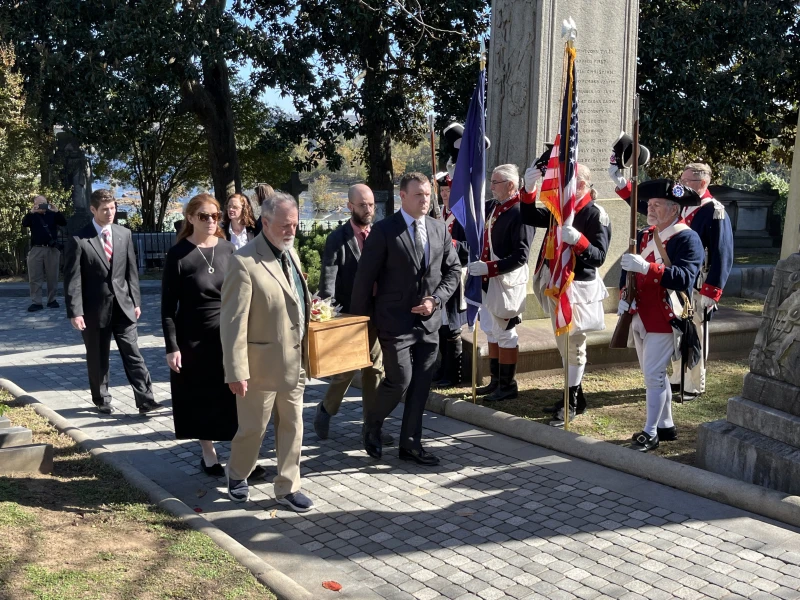

A color guard stands at attention as Eliza Monroe Hay’s remains are carried for reinterment at Hollywood Cemetery in Richmond, Virginia, on Thursday, Oct. 23, 2025. / Credit: Daniel Payne/CNA
Richmond, Virginia, Oct 23, 2025 / 17:04 pm (CNA).
Nearly two centuries after her death, the daughter of American Founding Father James Monroe has been laid to rest in Richmond, Virginia, joining her family’s historic burial plot in the city’s famed Hollywood Cemetery.
The Diocese of Richmond held Eliza Monroe Hay’s reinterment at the top of Hollywood Cemetery overlooking the James River on Oct. 23. Hay, who died in 1840, converted to Catholicism several years before her death.

State Sen. Bryce Reeves, who worked with the Eliza Project to repatriate Hay’s remains, said she was “far more than the daughter of a president.”
He described Hay as strong-willed and intelligent. “She served this nation quietly but powerfully in its formative years,” he said.
The historic reinterment came about from a yearslong effort by the Eliza Project to bring Hay’s mortal remains home from the Cimetière du Père-Lachaise, a cemetery on the outskirts of Paris.

Born in Fredericksburg, Virginia, in 1786, Hay grew up in both the U.S. and Paris, where her father was the American ambassador amid the ongoing French Revolution.
She would later be known for serving as an unofficial First Lady of the White House during James Monroe’s presidency, as her mother Elizabeth’s health regularly kept her away from state functions.
Hay’s husband, Virginia attorney George Hay, died in 1830, as did her mother. James Monroe died in 1831 and was by then one of a dwindling number of prominent U.S. citizens who had led the country through its founding and earliest years.
Hay herself subsequently returned to Paris, where she converted to Catholicism before she died.

A happy ending
Delivering Hay’s eulogy at the event, Virginia resident Barbara VornDick described Hay as “my friend from the past.”
VornDick said in an Oct. 21 press release that the effort “has been a fascinating, enriching journey in many ways,” though she said the “most amazing aspect was how it enriched my faith.”
She told the Arlington Catholic Herald in August that she spent years researching Hay’s life. She discovered that a popular family legend that Hay became a nun was untrue, but her conversion to Catholicism was confirmed by records at St.-Philippe-du-Roule Church in Paris, where her funeral Mass was held in 1840.
Hay also reportedly received a piece of jewelry from the Vatican — a cameo of the head of Christ — along with a note from Pope Gregory XVI’s secretary of state.
During her years at the White House, Hay gained a reputation as an unpleasant, demanding hostess. Reeves said at the Oct. 23 ceremony that Hay was at one time described by John Quincy Adams as an “obstinate little firebrand.”
The Eliza Project, however, says she had a record of “good deeds and generosity” that history has largely forgotten.
“She gained increasing admiration for her nursing of the sick: for family, for friends, and, during two epidemics, for the people of Washington,” the project said.
She also exhibited “a sense of duty and loyalty, strength of character and fortitude, and compassion for the sick and suffering.”

The Diocese of Richmond had earlier held a memorial Mass for Hay at the nearby Cathedral of the Sacred Heart before the interment at Hollywood Cemetery. Father Tony Marques, the rector of the cathedral, presided over the Rite of Committal on Oct. 23. The cathedral’s choir performed at the ceremony.
Describing the yearslong project to repatriate Hay’s remains as a “grassroots effort,” Reeves told the assembled crowd on Tuesday: “The Virginian thing to do was bring Eliza home.”
VornDick told the Herald that the yearslong effort to “bring Eliza home” was motivated by the likelihood that she “never intended to die” in Paris.
“I just wanted to make it right for her,” she said.
At the reinterment, meanwhile, VornDick described Hay as a “daughter, sister, wife, and grandmother,” one who stands out in history for her devotion, service, and forceful personality.
“Today marks the end of the Bring Eliza Home Project,” she said. “But it is a happy ending.”
Read More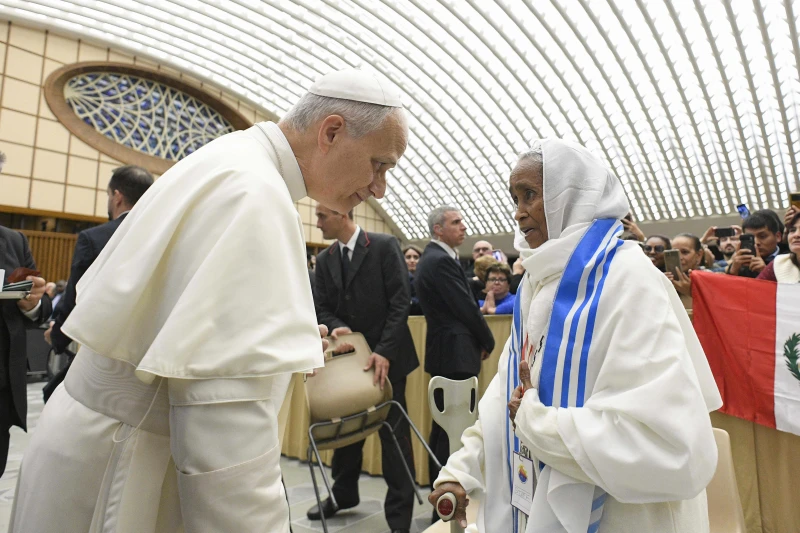

Pope Leo XIV meets with participants of the fifth World Meeting of Popular Movements on Oct. 23, 2025, in the Vatican’s Paul VI Audience Hall. / Credit: Vatican Media
Vatican City, Oct 23, 2025 / 15:26 pm (CNA).
Pope Leo XIV on Thursday decried the devastating impact of opioid addiction in the U.S., criticizing the pharmaceutical industry for its lack of “a global ethic” for the sake of profits.
In an Oct. 23 meeting with participants of the fifth World Meeting of Popular Movements held inside the Vatican’s Paul VI Audience Hall, the pope directly spoke out against “unbridled consumerism” and its negative impacts on people living in both poor and wealthy nations.
“In the current culture, with the help of advertising and publicity, a cult of physical well-being is being promoted, almost an idolatry of the body and, in this vision, the mystery of pain is reduced to something totally inhuman,” he said.
“This can lead also to dependence on pain medications, the sale of which obviously goes to increasing the earnings of the same pharmaceutical companies,” he continued. “This also leads to dependence on opioids, as has been devastating particularly in the United States.”
Describing fentanyl as the “drug of death” and the “second most common cause of death among the poor” in the U.S., the pope said the harm of such synthetic drugs extends beyond the country’s borders.
“The spread of new synthetic drugs, ever more lethal, is not only a crime involving trafficking of drugs but really has to do with the production of pharmaceuticals and their profit, lacking a global ethic,” he said on Thursday.
Besides the pharmaceutical industry, the Holy Father also criticized the influence of big tech in promoting unhealthy, consumerist behaviors among people of all ages.
“How can a poor young person live with hope and without anxiety when the social media constantly exalt an unbridled consumerism and a totally unrealizable level of economic success?” he said.
“Another problem not often recognized is represented by the dependency on digital gambling,” he continued. “The platforms are designed to create compulsive dependence and generate addictive habits that create addiction.”
Throughout the Oct. 23 gathering, the Holy Father expressed his solidarity with social leaders who are “moved by the desire of love” in order to “find solutions in a society dominated by unjust systems” present in the world today.
“Your many and creative initiatives can become new public policies and social rights. Yours is a legitimate and necessary effort,” he told those present at the audience.
“This makes you champions of humanity, witnesses to justice, poets of solidarity,” he added.
Read MoreBeyond The Beacon Episode 99: How your gift powers hope across the three counties of the diocese #Catholic – ![]()
How can a food pantry in one of the most impoverished cities in New Jersey feed 22,000 people each month? What does it take to empower the staff and volunteers of a drug and alcohol treatment center that helps hundreds of people in recovery every day? These questions and more are at the center of the latest episode of Beyond The Beacon.
Tim Potter and Scott Milliken are the guests on this episode, which explores how the annual Diocesan Ministries Appeal is having a significant impact on many lives across the three counties of the Diocese of Paterson.
Potter is chief development officer for the Diocese of Paterson, and Milliken is chief executive officer of Catholic Charities of the Diocese of Paterson. They join co-hosts Bishop Kevin J. Sweeney and Communications Director Jai Agnish.
The annual Diocesan Ministries Appeal funds seminary education, priest retirement and health care needs, Catholic Urban Education, and Catholic Charities. Learn more by listening or watching!
Listen to the episode here, or on any major podcast platform, or watch it on Bishop Sweeney’s YouTube channel.
Click here to subscribe to our weekly newsletter.
– ![]() How can a food pantry in one of the most impoverished cities in New Jersey feed 22,000 people each month? What does it take to empower the staff and volunteers of a drug and alcohol treatment center that helps hundreds of people in recovery every day? These questions and more are at the center of the latest episode of Beyond The Beacon. Tim Potter and Scott Milliken are the guests on this episode, which explores how the annual Diocesan Ministries Appeal is having a significant impact on many lives across the three counties of the Diocese of Paterson. Potter is
How can a food pantry in one of the most impoverished cities in New Jersey feed 22,000 people each month? What does it take to empower the staff and volunteers of a drug and alcohol treatment center that helps hundreds of people in recovery every day? These questions and more are at the center of the latest episode of Beyond The Beacon. Tim Potter and Scott Milliken are the guests on this episode, which explores how the annual Diocesan Ministries Appeal is having a significant impact on many lives across the three counties of the Diocese of Paterson. Potter is

WASHINGTON, D.C. — Amid an ongoing government shutdown, members of the U.S. Congress reassured the American public on Thursday that the paychecks of the U.S. Congress would not be affected.
Read More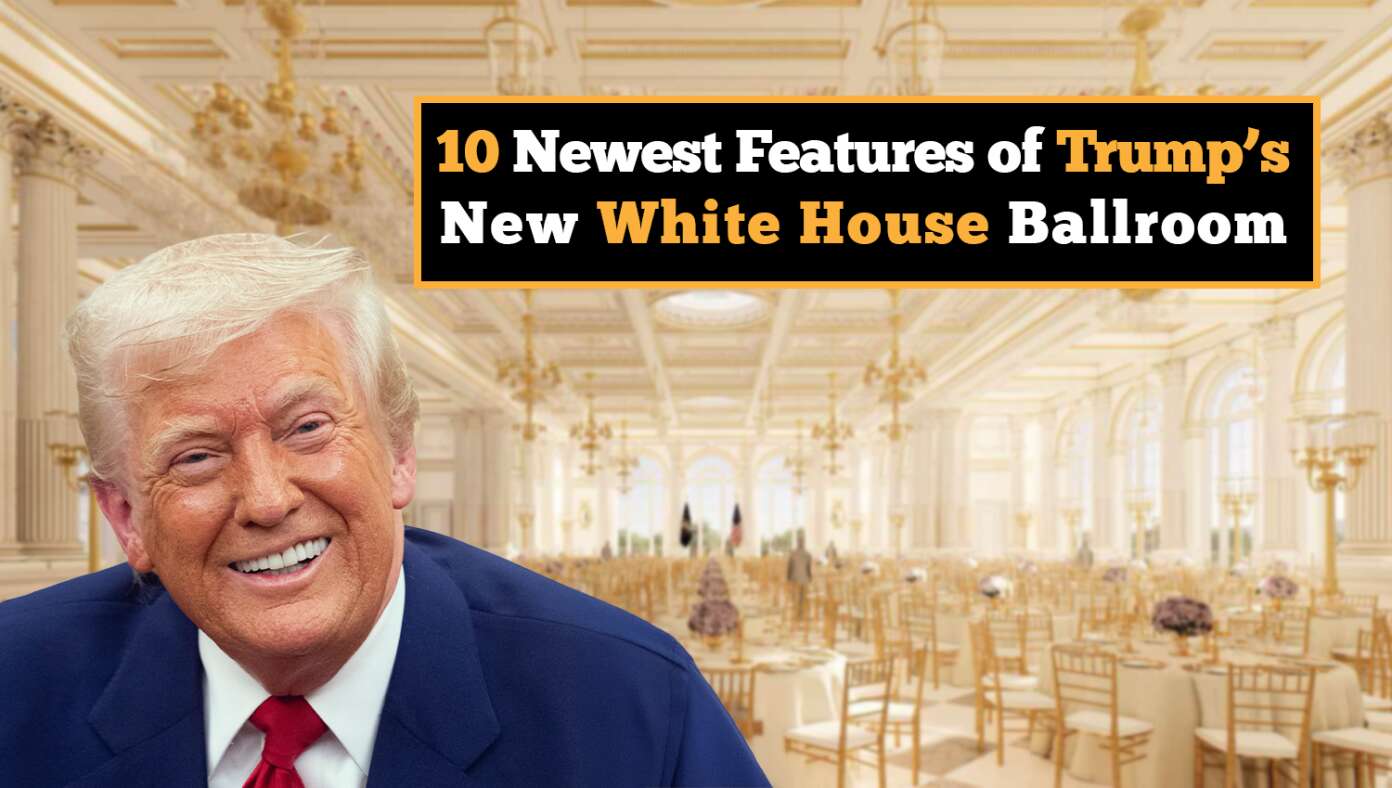
President Donald Trump’s project to construct a new grand ballroom at the White House has been grabbing all the headlines, but have you heard about all the amazing features it’s going to include?
Read More


U.S. Vice President JD Vance tours the Church of the Holy Sepulchre in the Old City of Jerusalem on Thursday, Oct. 23, 2025. / Credit: Nathan HOWARD / POOL / AFP / Getty Images
Washington, D.C. Newsroom, Oct 23, 2025 / 13:20 pm (CNA).
U.S. Vice President JD Vance and his wife, Usha, attended a private Mass celebrated by Franciscan monks at the Church of the Holy Sepulchre in Jerusalem on Thursday during a three-day diplomatic trip to Israel.
Vance, the nation’s second Catholic vice president, met with a group of bishops and went to confession prior to Mass, according to the White House Pool Report.
The Church of the Holy Sepulchre was constructed in the early fourth century during the reign of Constantine the Great, the first Roman emperor to convert to Christianity. It is jointly operated by the Catholic Church, the Greek Orthodox Church, and four Oriental Orthodox churches.
According to tradition, the church is built on the site of Jesus Christ’s crucifixion, burial, and resurrection. It is a premier pilgrimage destination for Christians who visit the Holy Land.
“What an amazing blessing to have visited the site of Christ’s death and resurrection,” Vance later said in a post on X. “I am immensely grateful to the Greek, Armenian, and Catholic priests who care for this most sacred of places. May the Prince of Peace have mercy on us and bless our efforts for peace.”
During his visit, Vance knelt in silent prayer in front of The Stone of Anointing. Many believe this to be the stone on which Jesus Christ’s body was anointed with oils and balms before his burial.
He also prayed before the Calvary Altar, which is believed to be the location where Christ was crucified.
According to the pool report, Vance and his wife both lit candles in the church. Vance also lit two candles with fire from Christ’s tomb to bring back to the United States.
“We are sending these lights to the White House,” an Armenian Orthodox bishop said, according to the pool report. “May God bless America, the United States, and Armenia and our friendship.”
Vance’s trip to Israel comes as the White House is working with Israel and Hamas to maintain a ceasefire, which halted a two-year-long war in Gaza. Earlier during his trip, he asked Christians to pray for peace in the region.
“Christians have many titles for Jesus Christ — and one of them is the Prince of Peace,” the vice president said. “And I’d ask people of all faiths, in particular my fellow Christians, to pray that the Prince of Peace can continue to work a miracle in this region of the world.”
“I think with your prayers and with God’s providence, and with a very good team behind me, I think we’re going to get it done,” he said.
Read More
With everything from wholesome, family run hills to Olympic-caliber mountains, this state takes the crown with the most ski resorts in the country.
Read MoreIn a recent study, a team of researchers from NASA Goddard Space Flight Center and Penn State suggested that future missions to Mars search for microbes or their remains in that planet’s ice, rather than in its rocks, clay, or soil. In a lab, the team recreated conditions that exist in the permafrost and iceContinue reading “Can Mars’ ice confirm past life?”
The post Can Mars’ ice confirm past life? appeared first on Astronomy Magazine.
Read More
The risen Christ brings joy, hope along life’s journey, pope says #Catholic – ![]()
VATICAN CITY (CNS) — The joy of Christ’s resurrection can repair the widespread sadness and malaise in today’s world, Pope Leo XIV said.
“On the paths of the heart, the Risen One walks with us and for us,” the pope said Oct. 22 during his weekly general audience in St. Peter’s Square.
“It is the Risen One who radically changes our perspective, instilling hope that fills the void of sadness,” he said.
Greeting Polish-speaking visitors during the audience, the pope highlighted that Oct. 22 marked the feast of St. John Paul II, the date of his inaugural Mass in 1978, during which he proclaimed, “Do not be afraid! Open wide the doors to Christ.”
“Exactly 47 years ago, in this square, he urged the world to open itself to Christ,” Pope Leo said. “This appeal is still valid today: We are all called to make it our own.”
Click here to subscribe to our weekly newsletter.
The month of October is dedicated to the rosary, he told French-speakers, and to prayer, reflection and action in support of its missionary work, he added in Italian.
All Catholics are invited “to renew our active cooperation in the mission of the church,” he said.
“With the power of prayer, the potential of married life and the fresh energy of youth, may you be missionaries of the Gospel, offering your concrete support to those who dedicate their lives to the evangelization of peoples,” he told young people and newlyweds who had come to the audience in their wedding attire to receive a blessing from him.
Meanwhile, in his ongoing series of audience talks on the Jubilee theme, “Jesus Christ our Hope,” Pope Leo reflected on how Christ’s resurrection “can heal one of the malaises of our time: sadness.”
“Intrusive and widespread, sadness accompanies the days of many people,” he said in his main address in Italian. “Sadness robs life of meaning and vigor, turning it into a directionless and meaningless journey.”
A similar scenario can be seen in the Gospel of Luke’s account of the two disciples on the road to Emmaus, he said. “Disappointed and discouraged, they leave Jerusalem, leaving behind the hopes they held in Jesus, who has been crucified and entombed.”
However, they met a stranger along the road who listened to them, “allowing them to unburden their disappointment,” the pope said. A bit of hope is rekindled in their hearts when the stranger rebukes them for being slow to believe everything that the prophets have declared, “that Christ had to suffer, die and rise again.”
It is only after they sit down and break bread with the “mysterious traveling companion” that the two disciples recognize him as Jesus, and he immediately disappears from their view, he said.
“Everything becomes clear: the shared journey, the tender and powerful word, the light of truth,” Pope Leo said. “Immediately, joy is rekindled, energy flows back into their weary limbs, and gratitude returns to their memory.”
Their souls are filled “with an unexpected and joyful realization: Christ is truly risen!” he said in English. “The Lord wishes to do the same for us, by dispelling any sadness and desperation that we may be feeling.”
“The Lord has truly been raised,” in deeds, not words, “with his body bearing the marks of his passion, a perennial seal of his love for us,” the pope said in Italian. “The victory of life is not an empty word, but a real, tangible fact.”
“May the unexpected joy of the disciples of Emmaus be a gentle reminder to us when the going gets tough,” he said. “It is the Risen One who radically changes our perspective, instilling hope that fills the void of sadness.”
Despite the darkness of his passion, “he bears witness to the defeat of death and affirms the victory of life,” he said. “History still has much goodness to hope for.”
“To recognize the Resurrection means to change one’s outlook on the world: to return to the light to recognize the truth that has saved us, and that saves us,” he said. Jesus alone “makes the impossible possible!”
– ![]() VATICAN CITY (CNS) — The joy of Christ’s resurrection can repair the widespread sadness and malaise in today’s world, Pope Leo XIV said. “On the paths of the heart, the Risen One walks with us and for us,” the pope said Oct. 22 during his weekly general audience in St. Peter’s Square. “It is the Risen One who radically changes our perspective, instilling hope that fills the void of sadness,” he said. Greeting Polish-speaking visitors during the audience, the pope highlighted that Oct. 22 marked the feast of St. John Paul II, the date of his inaugural Mass in 1978,
VATICAN CITY (CNS) — The joy of Christ’s resurrection can repair the widespread sadness and malaise in today’s world, Pope Leo XIV said. “On the paths of the heart, the Risen One walks with us and for us,” the pope said Oct. 22 during his weekly general audience in St. Peter’s Square. “It is the Risen One who radically changes our perspective, instilling hope that fills the void of sadness,” he said. Greeting Polish-speaking visitors during the audience, the pope highlighted that Oct. 22 marked the feast of St. John Paul II, the date of his inaugural Mass in 1978,
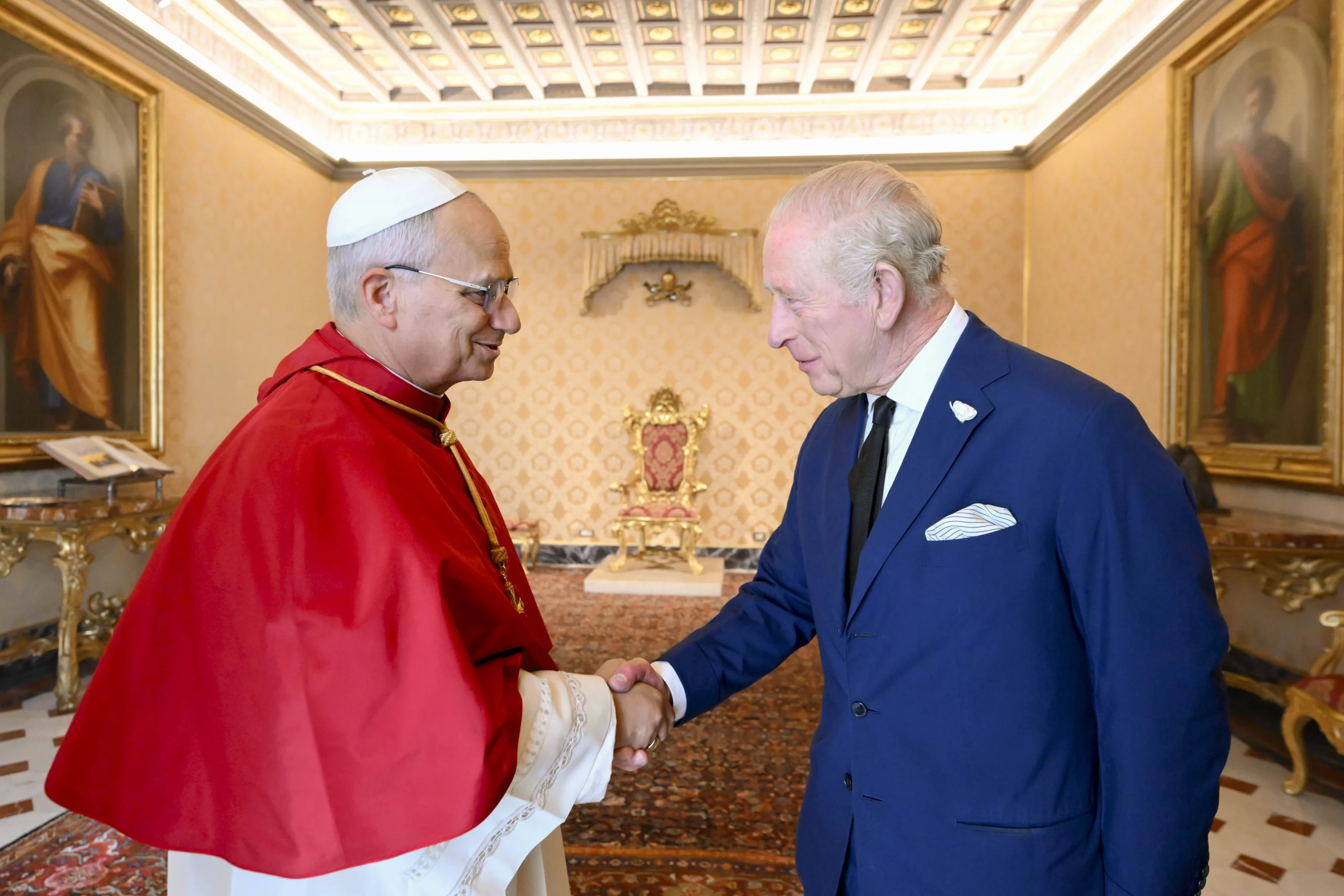

Pope Leo XIV and King Charles III walk together in the Sistine Chapel during a historic meeting that included a prayer service at the Vatican, Thursday, Oct. 23, 2025. / Credit: Vatican Media
Vatican City, Oct 23, 2025 / 09:34 am (CNA).
History was made in the Sistine Chapel on Thursday as Pope Leo XIV and King Charles III prayed side by side, marking the first time since the Protestant Reformation that a reigning British monarch and a pope have prayed together during a royal state visit to the Vatican.
Pope Leo XIV led the midday prayer of the Divine Office, standing beneath Michelangelo’s fresco of “The Last Judgment” and flanked by Anglican Archbishop of York Stephen Cottrell, King Charles, and Queen Camilla.

The ecumenical prayer service featured the Sistine Chapel Choir along with the choirs from St. George’s Chapel at Windsor Castle and His Majesty’s Chapel Royal.
The choirs sang “Come, Holy Ghost, Who Ever One,” a hymn by St. Ambrose translated into English by St. John Henry Newman. Pope Leo will declare Newman, the 19th-century English cardinal and Anglican convert, a doctor of the Church on Nov. 1.
King Charles attended Newman’s canonization in 2019 and recently became the first British monarch to visit the Birmingham Oratory, which Newman founded in 1848.

During the prayer, the choirs sang verses of Psalms 8 and 64 in Latin and English. A reading from St. Paul’s Letter to the Romans (8:22–27) was read aloud before Pope Leo and Cottrell offered the closing prayer together in English.
Cardinals, bishops, and Anglican representatives attended the prayer service, which was the highlight of the king’s first state visit to the Holy See since his accession in 2022.
As part of the state visit, Pope Leo approved the conferral of a new title on the monarch: “Royal Confrater” of the Papal Basilica of St. Paul Outside the Walls. Cardinal James Michael Harvey, the basilica’s archpriest, will formally bestow the honor during an afternoon ecumenical service at the tomb of St. Paul.
In return, Pope Leo XIV was offered the title of “Papal Confrater” of St. George’s Chapel in Windsor Castle, an invitation Pope Leo accepted.
“These mutual gifts of ‘confraternity’ are recognitions of spiritual fellowship and are deeply symbolic of the journey the Church of England (of which His Majesty is Supreme Governor) and the Roman Catholic Church have traveled over the past 500 years,” the British Embassy to the Holy See said in a statement.

Before the prayer service, King Charles and Queen Camilla met privately with Pope Leo in the Apostolic Palace. The king also met with Cardinal Pietro Parolin, the Vatican secretary of state, and Archbishop Paul Gallagher, the Vatican’s foreign minister. The Vatican said discussions focused on environmental protection, fighting poverty, and promoting ecumenical dialogue.
“Particular attention was given to the shared commitment to promoting peace and security in the face of global challenges,” the Holy See Press Office said.
King Charles also conferred on the pope the honor of Knight Grand Cross of the Order of Bath, while the pope conferred on the king the honor of Knight Grand Cross with the Collar of the Vatican Order of Pope Pius IX and on Queen Camilla the honor of Dame Grand Cross of the same order.
The royal visit comes as King Charles continues treatment for cancer, first diagnosed in early 2024.
Buckingham Palace said that the king’s state visit — postponed earlier this year due to the poor health of Pope Francis — celebrates both the Church’s 2025 Jubilee Year and “the ecumenical work between the Church of England and the Catholic Church, reflecting the jubilee year’s theme of walking together as ‘Pilgrims of Hope.’”
Following the Sistine Chapel service, Pope Leo and King Charles met business and church leaders in the Apostolic Palace’s Sala Regia for a discussion on environmental sustainability and care for creation.
After the Vatican meetings, King Charles is scheduled to visit the Basilica of St. Paul Outside the Walls, reviving the historic ties between England and the papal basilica. After the arrival in England of Roman monk-missionaries such as St. Augustine of Canterbury and St. Paulinus of York in the sixth and seventh centuries, Saxon rulers including Kings Offa and Æthelwulf contributed to the upkeep of the apostles’ tombs in Rome.
By the late Middle Ages, the kings of England were recognized as “protectors” of the Basilica of St. Paul and abbey, and its heraldic shield came to include the insignia of the Order of the Garter. That tradition was interrupted by the Reformation and the ensuing centuries of estrangement.
A newly commissioned chair bearing the royal coat of arms and the Latin phrase “Ut unum sint” (“That they may be one”) has been installed in the Basilica of St. Paul Outside the Walls for King Charles and his successors to use during future visits.
King Charles visited the Vatican several times as Prince of Wales, including for the funeral of John Paul II and for Newman’s canonization. His last papal audience was with Pope Francis in April, shortly before Francis’ death, though that was not an official state visit.
Queen Elizabeth II, Charles’ mother, met five popes during her 70-year reign but never participated in a public prayer with any of them.
Read More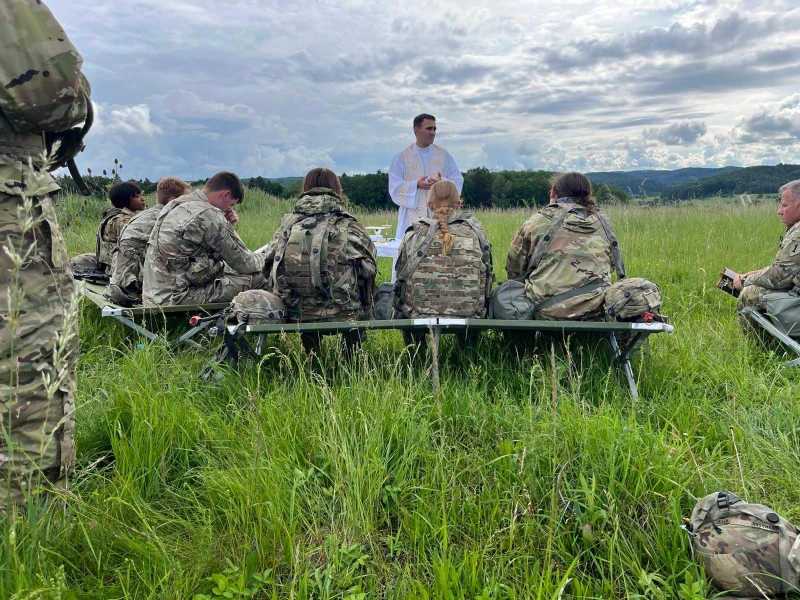

Father Adam Muda, a chaplain for the U.S. Army, celebrates Mass on the field with soldiers while in Germany. / Credit: Photo courtesy of Father Adam Muda
CNA Staff, Oct 23, 2025 / 07:00 am (CNA).
During Pastoral Care Week, celebrated Oct. 19–25, a Catholic psychotherapist encouraged a group of Catholic chaplains and ministers to pursue prayer, rest, and self-care in light of burnout — a challenge that often accompanies their unique work.
At an Oct. 22 webinar, “Carrying the Cross Without Burnout: Self-Care for Catholic Chaplains,” Adrienne Koller, a Catholic psychotherapist and founder of Strong Self Psychotherapy, encouraged chaplains to make time for spiritual and emotional renewal.
The webinar, organized by the National Association of Catholic Chaplains (NACC), a group that educates and supports Catholic chaplains across the country, highlighted the importance of finding rest amid the emotional toll of ministry.
“God doesn’t call us to self-erasure,” Koller told the nearly 100 chaplains who attended the webinar. “He calls us to stewardship of our bodies, our minds, and spirits.”

Koller described self-care as “stewardship” and “caring for the vessel God entrusted to you.”
“One of the most powerful mindset shifts I’ve seen in ministry is this: Self-care is not selfishness; it’s stewardship,” Koller said. “You are the vessel God entrusted with the work he gave you, and taking care of that vessel honors him.”
“You’re not taking away from your calling. You’re strengthening it,” she said. “Renewal isn’t an indulgence — it’s obedience.”
Erica Cohen Moore, executive director of NACC, highlighted the importance of caring for chaplains, both during Pastoral Care Week and throughout the year.
“Our chaplains are often called into spaces where few others are willing or able to go,” Cohen Moore told CNA. “They serve people in some of the most marginalized and challenging situations, where grief and suffering can be profound.”
Pastoral Care Week “gives opportunities for organizations and institutions of all types to recognize the spiritual caregivers in their midst and the ministry that the caregivers provide,” according to the NACC’s website.
Chaplains are often priests, but seminarians, deacons, religious brothers and sisters, and laymen and laywomen can all serve as chaplains, providing professional spiritual and emotional support in a range of areas — often in prisons, hospitals, fire departments, and campuses.
To help prepare and support chaplains, the NACC offers a variety of resources, training, community, and support for chaplains, both Catholic and non-Catholic.
What does burnout look like?
“Over the years, I’ve walked with countless individuals who appear incredibly strong on the outside yet wrestle with exhaustion, doubt, or the feeling that their work has taken more from them than they have time to replenish,” Koller told attendees.
Koller noted that the “emotional weight” of service can lead to burnout.
“That emotional weight, it doesn’t mean you’re doing something wrong; it means you’re human,” she said. “But we do take on that emotional weight, and that can lead, if unchecked, to burnout.”
“Burnout doesn’t happen because we’re weak or we’re incapable,” Koller continued. “It happens because we care deeply, we give fully, and sometimes we forget to refill our own cup.”
To combat the weight of service, Koller encouraged ministers to pray before and after each difficult meeting or encounter, and to offer the weight of those challenges to the Lord. She also led the group in grounding prayer exercises that incorporate breathing into prayer.

Cohen Moore noted that burnout is a “very real concern” that chaplains face — one that her organization works to combat through the resources they provide.
The association educates chaplains with a program called Clinical Pastoral Education (CPE), which is “a process that equips them to manage burnout and care for themselves and one another,” according to Cohen Moore.
The group also offers webinars on topics such as self-care, mental illness and trauma, and mental health, as well as networking groups and in-person gatherings, and publishes a magazine called Works of Hope.
The association plans to launch a learning institute early next year to include a course on “sustaining pastoral ministers and helping them avoid burnout,” Cohen Moore said.
“Burnout is a very real concern in our field, and we take it seriously as we continue exploring new ways to provide care and connection,” Cohen Moore said.
‘I will give you rest’
When Koller speaks with “those in service, especially chaplains and first responders,” she said that one verse “always comes to mind.”
In Matthew 11:28, Jesus says: “Come to me, all you who labor and are burdened, and I will give you rest.”
Koller noted that Christ “doesn’t say: ‘Keep pushing, work harder, work harder, deplete yourself, run yourself into the ground.”
“No — he says, ‘Come to me,’” she said.
“That invitation isn’t to perform,” Koller continued. “It’s to rest, in a way, to surrender the illusion that we have to carry everything alone. That’s where our renewal begins.”
Read More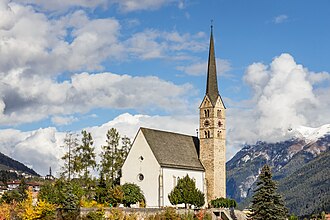
:max_bytes(150000):strip_icc():format(jpeg)/TAL-whiteface-mountain-ski-resort-ny-STMSTSKIRESRT1025-05c7850941504635a483c528c1147392.jpg)